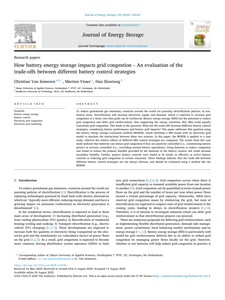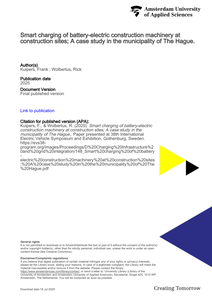To reduce greenhouse gas emissions, countries around the world are pursuing electrification policies. In residential areas, electrification will increase electricity supply and demand, which is expected to increase grid congestion at a faster rate than grids can be reinforced. Battery energy storage (BES) has the potential to reduce grid congestion and defer grid reinforcement, thus supporting the energy transition. But, BES could equally exacerbate grid congestion. This leads to the question: What are the trade-offs between different battery control strategies, considering battery performance and battery grid impacts? This paper addresses this question using the battery energy storage evaluation method (BESEM), which interlinks a BES model with an electricity grid model to simulate the interactions between these two systems. In this paper, the BESEM is applied to a case study, wherein the relative effects of different BES control strategies are compared. The results from this case study indicate that batteries can reduce grid congestion if they are passively controlled (i.e., constraining battery power) or actively controlled (i.e., overriding normal battery operations). Using batteries to reduce congestion was found to reduce the primary benefits provided by the batteries to the battery owners, but could increase secondary benefits. Further, passive battery controls were found to be nearly as effective as active battery controls at reducing grid congestion in certain situations. These findings indicate that the trade-offs between different battery control strategies are not always obvious, and should be evaluated using a method like the BESEM.
DOCUMENT

The intermittency of renewable energy technologies requires adequate storage technologies. Hydrogen systems consisting of electrolysers, storage tanks, and fuel cells can be implemented as well as batteries. The requirements of the hydrogen purification unit is missing from literature. We measured the same for a 4.5 kW PEM electrolyser to be 0.8 kW for 10 min.A simulation to hybridize the hydrogen system, including its purification unit, with lithium-ion batteries for energy storage is presented; the batteries also support the electrolyser. We simulated a scenario for operating a Dutch household off-electric-grid using solar and wind electricity to find the capacities and costs of the components of the system.Although the energy use of the purification unit is small, it influences the operation of the system, affecting the sizing of the components. The battery as a fast response efficient secondary storage system increases the ability of the electrolyser to start up.
DOCUMENT
The need for increasing further the penetration of Renewable Energy Sources (RESs) is demanding a change in the way distribution grids are managed. In particular, the RESs intermittent and stochastic nature is finding in Battery Energy Storage (BES) systems its most immediate countermeasure. This work presents a reality-based assessment and comparison of the impact of three different BES technologies on distribution grids with high RES penetration, namely Li-ion, Zn-Air and Redox Flow. To this end, a benchmark distribution grid with real prosumers’ generation and load profiles is considered, with the RES penetration purposely scaled up in such a way as to violate the grid operational limits. Then, further to the BES(s) placement on the most affected grid location(s), the impact of the three BES types is assessed considering two Use Cases: 1) Voltage & Congestion Management and 2) Peak Shaving & Energy shifting. Assessment is conducted by evaluating a set of technical Key Performance Indicators (KPIs), together with a simplified economic analysis.
DOCUMENT
Battery energy storage (BES) can provide many grid services, such as power flow management to reduce distribution grid overloading. It is desirable to minimise BES storage capacities to reduce investment costs. However, it is not always clear how battery sizing is affected by battery siting and power flow simultaneity (PFS). This paper describes a method to compare the battery capacity required to provide grid services for different battery siting configurations and variable PFSs. The method was implemented by modelling a standard test grid with artificial power flow patterns and different battery siting configurations. The storage capacity of each configuration was minimised to determine how these variables affect the minimum storage capacity required to maintain power flows below a given threshold. In this case, a battery located at the transformer required 10–20% more capacity than a battery located centrally on the grid, or several batteries distributed throughout the grid, depending on PFS. The differences in capacity requirements were largely attributed to the ability of a BES configuration to mitigate network losses. The method presented in this paper can be used to compare BES capacity requirements for different battery siting configurations, power flow patterns, grid services, and grid characteristics.
DOCUMENT

The ever-increasing electrification of society has been a cause of utility grid issues in many regions around the world. With the increased adoption of electric vehicles (EVs) in the Netherlands, many new charge points (CPs) are required. A common installation practice of CPs is to group multiple CPs together on a single grid connection, the so-called charging hub. To further ensure EVs are adequately charged, various control strategies can be employed, or a stationary battery can be connected to this network. A pilot project in Amsterdam was used as a case study to validate the Python model developed in this study using the measured data. This paper presents an optimisation of the battery energy storage capacity and the grid connection capacity for such a P&R-based charging hub with various load profiles and various battery system costs. A variety of battery control strategies were simulated using both the optimal system sizing and the case study sizing. A recommendation for a control strategy is proposed.
DOCUMENT

The application of DC grids is gaining more attention in office applications. Especially since powering an office desk would not require a high power connection to the main AC grid but could be made sustainable using solar power and battery storage. This would result in fewer converters and further advanced grid utilization. In this paper, a sustainable desk power application is described that can be used for powering typical office appliances such as computers, lighting, and telephones. The desk will be powered by a solar panel and has a battery for energy storage. The applied DC grid includes droop control for power management and can either operate stand-alone or connected to other DC-desks to create a meshed-grid system. A dynamic DC nano-grid is made using multiple self-developed half-bridge circuit boards controlled by microcontrollers. This grid is monitored and controlled using a lightweight network protocol, allowing for online integration. Droop control is used to create dynamic power management, allowing automated control for power consumption and production. Digital control is used to regulate the power flow, and drive other applications, including batteries and solar panels. The practical demonstrative setup is a small-sized desktop with applications built into it, such as a lamp, wireless charging pad, and laptop charge point for devices up to 45W. User control is added in the form of an interactive remote wireless touch panel and power consumption is monitored and stored in the cloud. The paper includes a description of technical implementation as well as power consumption measurements.
DOCUMENT

Electrification of residential areas is increasingly common. Major areas of development include rooftop solar panels, electric vehicles and heat pumps. However, existing grid components may have insufficient network capacity to accommodate the resulting electricity flows. Battery energy storage (BES) can be used to prevent transformer overloading resulting from electrification. Ideally, BES should be sized and placed such that it can prevent overloading with a minimum amount of storage capacity, but it is unclear how load characteristics affect BES capacity requirements. This study investigated how load simultaneity affects the minimum BES capacity required to prevent transformer overloading, comparing a central with a distributed BES layout. It was found that as simultaneity increases, distributed storage requires relatively less capacity than central storage. This is likely due to the reduced ability of central BES to share capacity between connections as simultaneity increases, and the ability of distributed BES to better reduce transportation losses.
DOCUMENT
This paper investigates smart charging strategies for battery-electric construction machinery (non-road mobile machinery, NRMM) through a case study of a large-scale housing project in The Hague, Netherlands. The study develops a methodology to estimate energy demands and simulate charging profiles during various construction phases. Using a combination of smart charging and temporary battery storage, the paper demonstrates that peak grid loads can be significantly reduced—by up to 46%—compared to conventional charging strategies. Simulations reveal that grid limitations, especially during early construction phases, can be overcome with optimized load management and supplemental battery systems. The findings highlight the importance of smart charging infrastructure and energy planning in enabling the transition to zero-emission construction practices. This research contributes to the practical implementation of electric NRMM in urban construction projects, addressing one of the key bottlenecks in decarbonizing the construction sector.
DOCUMENT

The Johan Cruijff ArenA (JC ArenA) is a big events location in Amsterdam, where national and international football matches, concerts and music festivals take place for up to 68,000 visitors. The JC ArenA is already one of the most sustainable, multi-functional stadia in the world and is realizing even more inspiring smart energy solutions for the venue, it’s visitors and neighbourhood. The JC ArenA presents a complex testbed for innovative energy services, with a consumption of electricity comparable to a district of 2700 households. Thanks to the 1 MWp solar installation on the roof of the venue, the JC ArenA already produces around 8% of the electricity it needs, the rest is by certified regional wind energy.Within the Seev4-City project the JC ArenA has invested in a 3 MW/2.8 MWh battery energy storage system, 14 EV charging stations and one V2G charging unit. The plan was to construct the 2.8 MWh battery with 148 2nd life electric car batteries, but at the moment of realisation there were not enough 2nd life EV batteries available, so 40% is 2nd life. The JC ArenA experienced compatibility issues installing a mix of new and second-life batteries. Balancing the second-life batteries with the new batteries proved far more difficult than expected because an older battery is acting different compared to new batteries.The EV-based battery energy storage system is unique in that it combines for the first time several applications and services in parallel. Main use is for grid services like Frequency Containment Reserve, along with peak shaving, back-up services, V2G support and optimization of PV integration. By integrating the solar panels, the energy storage system and the (bi-directional) EV chargers electric vehicles can power events and be charged with clean energy through the JC ArenA’s Energy Services. These and other experiences and results can serve as a development model for other stadiums worldwide and for use of 2nd life EV batteries.The results of the Seev4-City project are also given in three Key Performance Indicators (KPI): reduction of CO2-emission, increase of energy autonomy and reduction in peak demand. The results for the JC ArenA are summarised in the table below. The year 2017 is taken as reference, as most data is available for this year. The CO2 reductions are far above target thanks to the use of the battery energy storage system for FCR services, as this saves on the use of fossil energy by fossil power plants. Some smaller savings are by replacement of ICEby EV. Energy autonomy is increased by better spreading of the PV generated, over 6 instead of 4 of the 10 transformers of the JC ArenA, so less PV is going to the public grid. A peak reduction of 0.3 MW (10%) is possible by optimal use of the battery energy storage system during the main events with the highest electricity demand.
DOCUMENT
